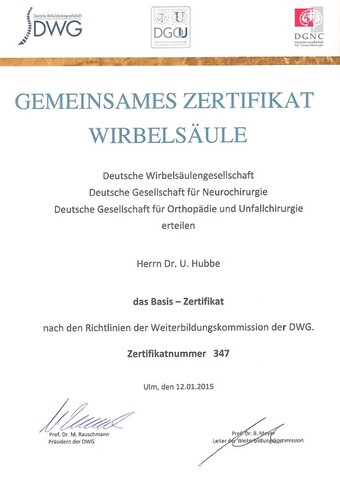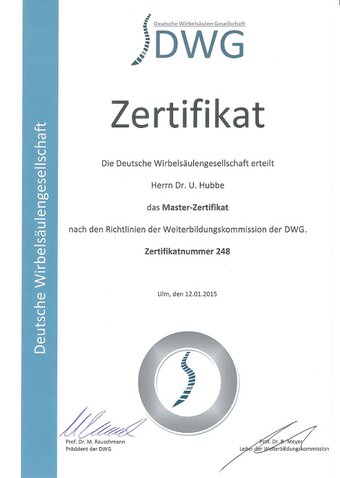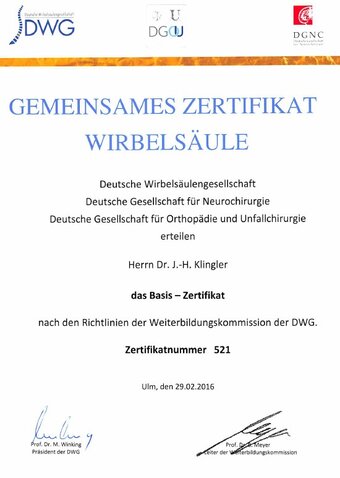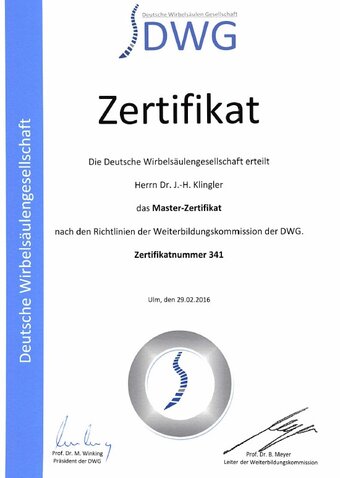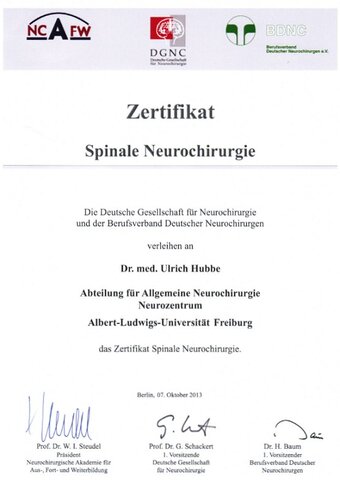Spine surgery
Spinal disorders are one of the most common reasons for a neurosurgical intervention. The neurosurgical spectrum at the Department of Neurosurgery includes the following spinal disorders:
- degenerative spinal disease
- inflammatory diseases
- neoplastic diseases of the spine
- lumbar, thoracic and cervical disc herniations
- lumbar and cervical spinal stenosis
- lumbar and cervical disc degeneration (disc disease)
- primary and secondary segmental instability of the cervical, thoracic and lumbar spine
- neoplastic and inflammatory spine destruction
- osteoporotic subsidence of the spine with neurological symptoms
All diseases mentioned above are treated using minimally invasive surgery techniques, if possible. The open surgical interventions on the spine are performed micro-surgically. Reconstructive surgery for the treatment of spinal instability is performed using the most advanced stabilization techniques and implants. We prefer dynamic, i.e. (partial) function preserving techniques (such as intervertebral disc endoprostheses, dynamic transpedicular fixation) over rigid stabilization systems for the surgical treatment of degenerative instabilities.
The care of patients with spinal disorders includes outpatient pre-operative evaluation during the special consultation hours for neurosurgical spinal disorders, the inpatient treatment period (perioperative diagnosis, surgery, physiotherapy) as well as a structured outpatient follow-up treatment. Extended spinal function tests (root and facet joint blocks, discographies, etc.) take place during a one day stay and, if necessary, as inpatient treatment. A close collaboration with the local multidisciplinary pain center exists.
For the first appointment within our special consultation hours for spine surgery we ask for current imaging findings (MRI of the spinal system) as well as the referral by a general physician.
Surgical treatment strategy
- Lumbar intervertebral disc herniation (minimally invasive / microsurgical decompression)
- Lumbar spinal stenosis (minimally invasive / microsurgical decompression)
- Degenerative lumbar instability (minimally invasive dynamic / rigid posterior stabilization, with or without intervertebral cage)
- Cervical disc herniation / cervical spinal stenosis (microsurgical decompression, disc prosthesis or fusion)
- Thoracic herniated disc (transthoracic microsurgical decompression and fusion)
- Osteoporotic subsidence (vertebroplasty / kyphoplasty, minimally invasive stabilization in hybrid technique, if necessary)
- Spondylodiscitis (minimally invasive percutaneous stabilization)
- Tumorous destruction of the spine (360 degree dorsoventral resection, stabilization)
In January 2015, Dr. Ulrich Hubbe received the "Joint Certificate of the Spine of the DWG, the DGNC and the DGOU" as well as the Master Certificate of the DWG.
In February 2016, Dr. Jan-Helge Klingler received the "Joint Certificate of the Spine of the DWG, the DGNC and the DGOU" as well as the master certificate of the DWG.
Short videos of successful neurosurgical spinal procedures

Prof. Dr. Ulrich Hubbe, MD
Senior neurosurgeon

Prof. Dr. Jan-Helge Klingler, MD
Senior neurosurgeon
Consultation hours for spine surgery

